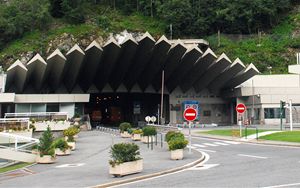(Finance) – There are many difficulties that the transport system is experiencing ai you pass alpine: the already known limitations in the tunnel of Gotthardthe interruption of the Frejus railway line, the interruptions already planned for works on the Brenner line now they are aggravated by the landslide that hit the A43 motorway in French Savoie on Sunday (resulting in the partial interruption of road traffic to the south and the suspension of the railway flow between France and Italy). All this rekindles attention on a closely related issue: starting next Monday, maintenance work is scheduled for the Mont Blanc tunnel, through which around 4,600 trucks pass a day, which would lead to a closure of 15 consecutive weeks.
In the meantime, at 18 yesterday the la was reopened Brenner railway line, closed from Monday morning on the Austrian side due to a landslide due to bad weather that affected the area. “The works made it possible to restore the line by freeing the tracks that had been invaded by debris between the villages of Steinach and the state border. The resumption of circulation – he specified Fry – will help ease the pressure on the Alpine crossings severely compromised by the bad weather“.
As regards the closure of the Mont Blanc tunnel, however, the hypothesis of a postponement of the closure scheduled for September 4 after the video call between the Minister of Infrastructure, Matteo Salviniand my transalpine colleague, Clement Beaune. More information will be available between tomorrow and Friday when the French checks on the section of the A43 hit by the landslide will be completed.
“Closing these critical links to our key export markets risks cutting our own export and to benefit other countries such as the Spain”, said the CEO of Italy supply chain, Luigi Scordamaglia. From east to west, every year, over 170 million tons of goods pass through the Italian Alps, 60% of what the country imports and exports, from and to the rest of the world.
Now, the succession of events adverse and of critical issues already known poses the concrete risk of blockages and bottlenecks, with direct consequences on the tissue economic, in particular for the record agri-food sector, which is the leader in the sector after reaching 60.7 billion in 2022 and registering +8% than in the first five months of this year. Almost two thirds (63%) of Italian agri-food exports concern the countries of the European Union, and are reached mainly through the Alpine passes. In fact, 88% of the goods that travel in Italy by road:
“It is not possible to continue to focus on such a fundamental asset for the country’s economy without investing adequately in logistic infrastructures, the need is to change a paradigm which over the years has led to 85% of our goods traveling by road – Scordamaglia concludes -. Well in this sense the investments of PNRR intended for logistics, aimed at reducing the highest cost in Europe to date, that of heavy transport equal to € 1.12 per km. It is also essential that these investments are excluded from the calculation of the public debt in the forthcoming EU stability pact.
(Photo: Christophe Jacquet CC BY-SA 3.0)
